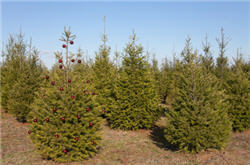
Tips Tuesday: Green Christmas Trees

It’s that holiday time of year again, now that the nation is full from Thanksgiving turkey and cranberry sauce; many people are shopping for Christmas trees facing a perennial question: which is the greener choice – real or fake?
Climate change expert Clint Springer, Ph.D., assistant professor of biology at Saint Joseph’s University in Philadelphia, says that while he prefers real trees because of their environmental benefits – which includes absorbing carbon dioxide and other gases while emitting fresh oxygen, according to the National Christmas Tree Association – consumers who opt for artificial trees can find other ways to green the holidays.
The myth of purchasing artificial trees with the idea of using it for years to come is better than a live tree has been debunked. On the contrary, the estimated 15,000 [plus] Christmas tree farms in the United States stabilize soil, protect water supplies and provide refuge for wildlife, according to the USDA, along with the eco-conscious benefits of being renewable and recyclable.
The USDA estimates approximately 25-30 million real Christmas trees are sold in the United States each year and more than 4,000 Christmas tree recycling programs throughout the U.S.
“Real trees are the optimal choice for the environment,” said Springer. “Since they use photosynthesis for energy, they act as a carbon ‘sink,’ taking excess CO2 from the atmosphere and storing it in their tissues and the surrounding soil. The carbon stays there for long periods of time because the land on which the crops grow is not tilled, thereby slowing its re-release into the atmosphere and lowering its potential to alter the climate.”
According to Springer, there are other sustainable benefits to purchasing real or live trees, but many families may not be able to make that choice.
“Some might live in areas where they don’t have access to real trees, or the trees may be too costly, or they might prefer the low-maintenance aspects of an artificial tree,” he says.
If you do choose an artificial tree, Springer recommends using LED lights for decoration and keeping it for as long as possible to lessen its environmental impact.
“People can also give environmentally friendly gifts, or can donate to agencies that benefit those most affected by climate change in the name of their friend or family member, like CARE International’s Poverty, Environment, & Climate Change Network,” he adds.
Artificial tree owners may be surprised to learn that their petroleum-based tree could contain lead, Springer cautions.
“Prior to 2007, lead was used as a stabilizer in the production of the polyvinyl chloride (PVC) that composes artificial trees and other Christmas decorations,” Springer said. “This problem is magnified because PVC is not biodegradable, so artificial trees will sit in landfills forever, and some of them will be leaking lead into the ground water.”
When choosing a real tree, variety, shape and size are all a matter of personal preference, Springer said. He offers the following tips for picking and caring for your tree:
• To ensure that your tree is fresh, buy from a “cut-your-own” farm. The more recently the tree has been cut, the longer a family can enjoy its beauty.
• If this is not an option, inspect the tree for freshness by giving it a hearty shake; check for needle loss.
• All trees, even those still growing, will lose some needles when shaken, but if you see an excessive amount, move on to another tree.
• Ask the seller to make a new cut on the trunk before taking it home and putting it in water.
• Make sure to water the tree daily. Depending on its size and the temperature of the room, a live tree can use as much as one to two gallons of water per day. It's not necessary to add anything to the water, like sugar, which provides no real benefit to the tree.